Askey Computer WLL6240 802.11 b/g/n Min PCI Card User Manual
Askey Computer Corp 802.11 b/g/n Min PCI Card
User Man_H8N-WLL6240

• 1
WLL6240(RoHS)
H8N-WL6240
AR5BMB97 MPCI Module
User's Guide
Revision November 2011

Atheros Communications, Inc. • 2
COMPANY CONFIDENTIAL November 2011 • 2
© 2000–2007 by Atheros Communications, Inc. All rights reserved.
Atheros®, Atheros Driven®, Atheros XR®, Driving the Wireless Future®, ROCm®, Super AG®, Super G®,
Total 802.11n®, and Wake on Wireless® are registered by Atheros Communications, Inc. Atheros SST™,
Signal-Sustain Technology™, the Air is Cleaner at 5-GHz™, XSPAN™, Wireless Future. Unleashed
Now.™, and 5-UP™ are trademarks of Atheros Communications, Inc. The Atheros logo is a registered
trademark of Atheros Communications, Inc. All other trademarks are the property of their respective
holders.
Subject to change without notice.
Notice
The information in this document has been carefully reviewed and is believed to be accurate.
Nonetheless, this document is subject to change without notice, and Atheros Communications, Inc.
(Atheros) assumes no responsibility for any inaccuracies that may be contained in this document, and
makes no commitment to update or to keep current the contained information, or to notify a person or
organization of any updates. Atheros reserves the right to make changes, at any time, in order to
improve reliability, function or design and to attempt to supply the best product possible. Atheros
does not represent that products described herein are free from patent infringement or from any other
third party right.
No part of this document may be reproduced, adapted or transmitted in any form or by any means,
electronic or mechanical, for any purpose, except as expressly set forth in a written agreement signed
by Atheros. Atheros or its affiliates may have patents or pending patent applications, trademarks,
copyrights, maskwork rights or other intellectual property rights that apply to the ideas, material and
information expressed herein. No license to such rights is provided except as expressly set forth in a
written agreement signed by Atheros.
ATHEROS MAKES NO WARRANTIES OF ANY KIND WITH REGARD TO THE CONTENT OF
THIS DOCUMENT. IN NO EVENT SHALL ATHEROS BE LIABLE FOR DIRECT, INDIRECT,
SPECIAL, INCIDENTAL SPECULATORY OR CONSEQUENTIAL DAMAGES ARISING FROM THE
USE OR INABILITY TO USE THIS PRODUCT OR DOCUMENTATION, EVEN IF ADVISED OF THE
POSSIBLITY OF SUCH DAMAGES. IN PARTICULAR, ATHEROS SHALL NOT HAVE LIABILITY
FOR ANY HARDWARE, SOFTWARE, OR DATA TRANSMITTED OR OTHERWISE USED WITH
THE PRODUCT, INCLUDING THE COSTS OF REPAIRING, REPLACING, INTEGRATING,
INSTALLING OR RECOVERING SUCH HARDWARE, SOFTWARE OR DATA. ATHEROS
SPECIFICALLY DISCLAIMS THE IMPLIED WARRANTIES OF MERCHANTIBILITY AND FITNESS
FOR A PARTICULAR PURPOSE AS THEY MIGHT OTHERWISE APPLY TO THIS DOCUMENT
AND TO THE IDEAS, MATERIAL AND INFORMATION EXPRESSED HEREIN.
WARNING: Warnings call special attention to hazards that can cause system damage, data
corruption, personal injury, or death.

Atheros Communications, Inc. • 3
COMPANY CONFIDENTIAL November 2011 • 3
Contents
Notice..........................................................................................................................2
Contents .............................................................................................................................. 3
Introduction......................................................................................................................... 4
AP Network Attachment and Configuration....................................................................... 5
AP Initial Configuration ................................................................................................. 6
Web Browser .............................................................................................................. 6
AP Web Server ...................................................................................................................9
Accessing the AP Web Server ........................................................................................ 9
Configuration Windows................................................................................................ 11
Working with Configuration Windows .................................................................... 12
2.4 GHz Radio Configuration Window ........................................................................ 13
Regulatory Compliance Information ................................................................................ 14
U.S. Regulatory Wireless Notice.................................................................................. 15

Atheros Communications, Inc. • 4
COMPANY CONFIDENTIAL November 2011 • 4
Introduction
The Atheros AR5BMB82 MPCI module implements an IEEE 802.11b/g/n wireless LAN
(WLAN) AP with DFS Master function. MIMO operation is implemented using three
transmit and three receive chains per the 802.11n standard.
This module may be installed in PC and host processor systems using approved external
antennas. The module may be configured for 2.4 GHz operation using the Web
Server function. Refer to Appendix A.

Atheros Communications, Inc. • 5
COMPANY CONFIDENTIAL November 2011 • 5
2
AP Network Attachment
and Configuration
This section provides procedures for connecting and configuring the AP. Configuration can
be performed either from a web browser accessing the built-in web server, or by entering
commands using the command line interface (CLI). For detailed information on using the
web server, refer to “AP Web Server” in Appendix A. For detailed information on using CLI,
refer to “AP Command-Line Interface” in Appendix B. For “Factory Default Settings” refer
to Appendix B.
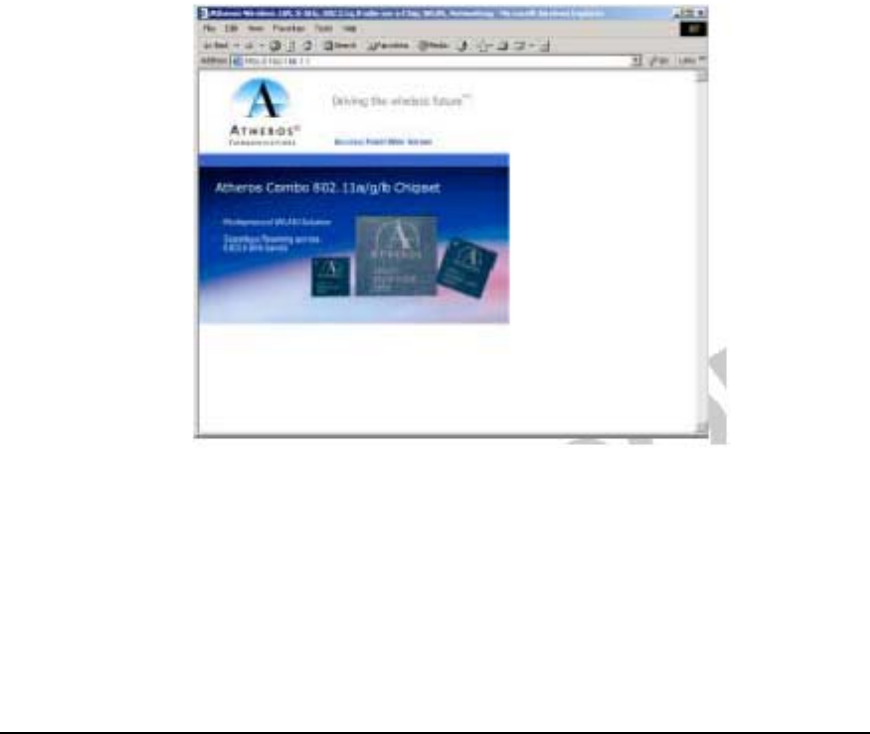
Atheros Communications, Inc. • 6
COMPANY CONFIDENTIAL November 2011
AP Initial Configuration
Configure the AP for its Service Set Identifier (SSID) unique to the application. This
configuration can be done either through a web browser with access to the built-in AP web
server, or by issuing commands through the command line interface (CLI).
Web Browser
Follow these steps to configure the channel frequency and SSID using a web browser:
1. Launch a web browser (Netscape Navigator or Internet Explorer are examples of
commonly used web browsers).
2. From the HPC, enter the IP address that is assigned to the AP as the URL address, for
example http://192.168.1.1.
The Access Point Web Server homepage will appear.
3. Select the Access Point Web Server hotlink.

Atheros Communications, Inc. • 7
COMPANY CONFIDENTIAL November 2011
4. A dialog box appears requesting login authorization. When prompted, enter the
following information to log in:
Log in: Admin (case-sensitive)
Password: 5up
5. Click OK to complete the login process. The 5 GHz Statistics window appears.

Atheros Communications, Inc. • 8
COMPANY CONFIDENTIAL November 2011 • 8
6. Select the Configuration hotlink from the navigation menu.
The System Configuration window appears.
7. Enter the SSID (name or address) for the AP in the SSID field. The SSID must be 1–32
characters in length.
To configure a single SSID to have more than one AP in a single SSID, specify a unique
System Name for each AP within that single SSID. Note that range of available channels
will be automatically determined by factory settings.
8. Click Update to commit the changes.
Change other settings at this time. Refer to Appendix A for more information.
9. After all configuration changes are complete, reboot the AP to enable them. To reboot the
AP, click on the REBOOT AP button that appears.
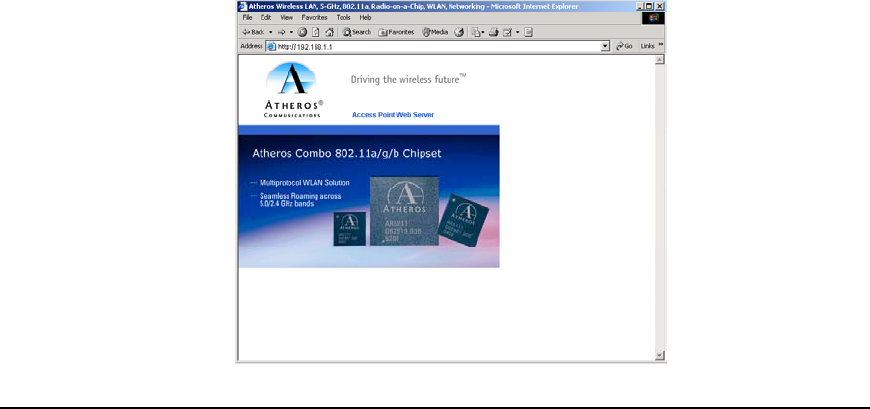
Atheros Communications, Inc. • 9
COMPANY CONFIDENTIAL November 2011 • 9
A
AP Web Server
Configure the access point (AP) either through a web browser interface to the AP web server,
or using the command-line interface (CLI) through telnet. The web server resides in the AP
and is accessible from any station (STA) that is connected to the AP Infrastructure network.
This appendix describes configuring the AP through the AP Web Server.
Accessing the AP Web Server
Follow these steps to access the AP Web Server:
1. Launch a web browser (Netscape Navigator or Internet Explorer are examples of
commonly used web browsers).
2. From the HPC, enter the IP address that is assigned to the AP as the URL address. For
example, enter http://192.168.1.1. The Access Point Web Server homepage appears.
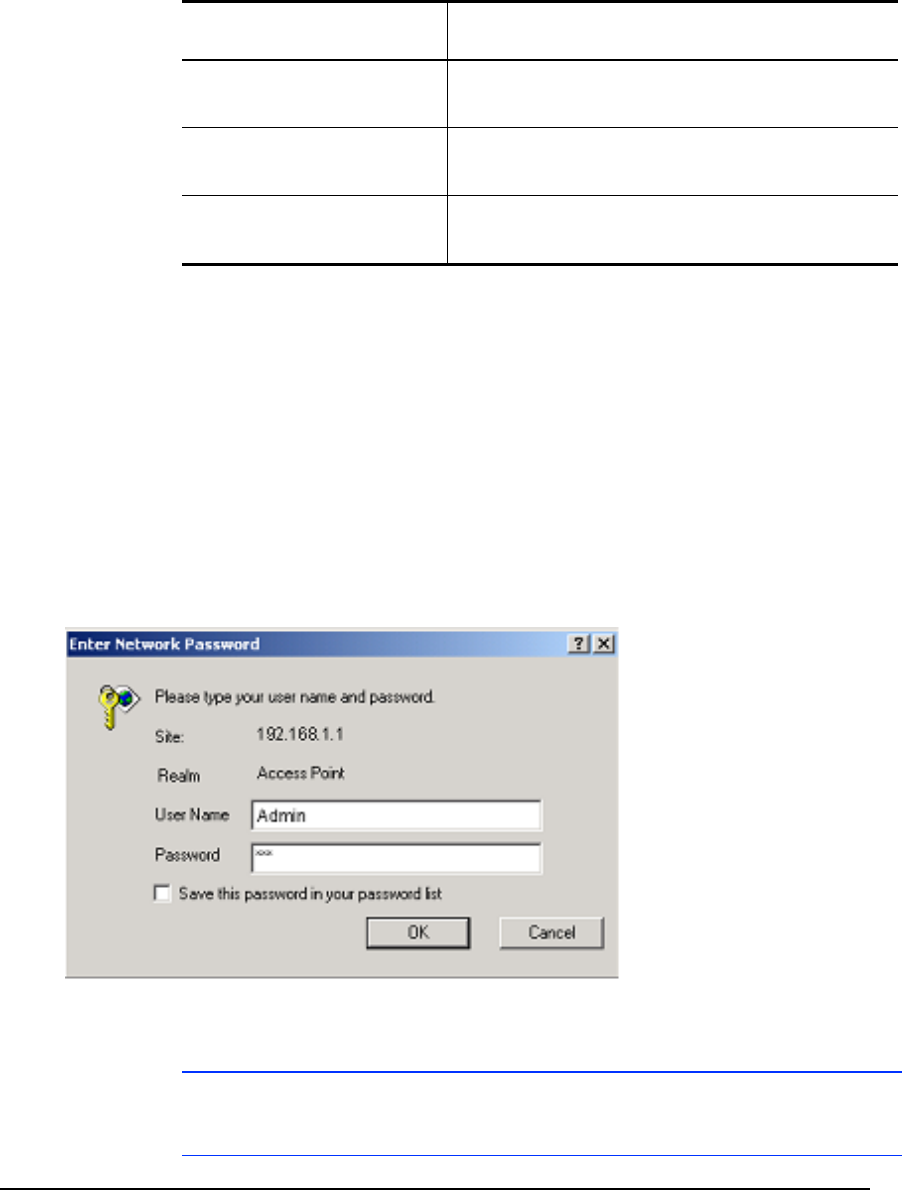
Atheros Communications, Inc. • 10
COMPANY CONFIDENTIAL November 2011 • 10
Customize the appearance of the Access Point Web Server homepage by replacing any of
the three .GIF files used on the page. Use FTP to store the replacement .GIF files to the
AP. This table summarizes the three .GIF files to replace to customize the homepage.
Filename Description
logo.gif Replaces the current Atheros logo with another .GIF
file.
tagline.gif Replaces the tagline “Driving the wireless future” with
a new tagline.
cover.jpe Replaces the Atheros AR5001AP chipset photograph
with a new photograph.
For example, the .GIF file containing the full path filename for a company logo can be
replaced with another .GIF file.
3. Select the Atheros Access Point Web Server hotlink.
4. A dialog box appears requesting login authorization. When prompted, enter the
following information to log in:
Log in: Admin (case sensitive)
Password: 5up
5. Click OK to complete the login process.
NOTE: The web browser must support frames and Java script must be
enabled.
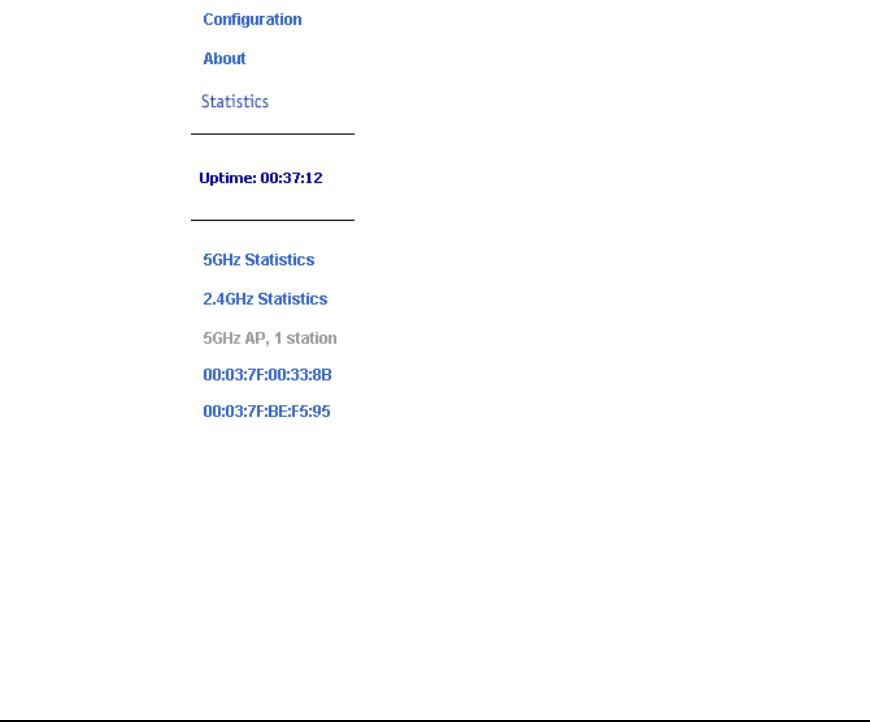
Atheros Communications, Inc. • 11
COMPANY CONFIDENTIAL November 2011 • 11
Configuration Windows
The Web Server Configuration windows allow viewing and editing of configuration
information for the AP. The Web Server provides configuration windows for:
■ System configuration parameters
■ 2.4 GHz radio configuration parameters
■ 2.4 GHz statistics
■ Security
■ Configuration scripts
■ Firmware updates
To access any of these AP configuration screens, click on the desired hotlink from the
navigation bar on any configuration screen:

Atheros Communications, Inc. • 12
COMPANY CONFIDENTIAL November 2011 • 12
Working with Configuration Windows
The Web Server Configuration windows provide a user-friendly interface to aid in quick
configuration of the AP. After making any additions or changes to any configuration
window, update the configuration file to save the changes. The new configuration is not in
effect until the AP is rebooted.
Follow these steps to update configuration files:
1. Enter the configuration updates or changes in the appropriate configuration fields.
2. Click
Update.
3. Click Reboot AP to make the changes
effective.
The web server loses connectivity with the Web Server as the AP reboots.
To reestablish the connection with the Web Server, wait until the AP has completed
rebooting and navigate to the Web Server to resume communication.
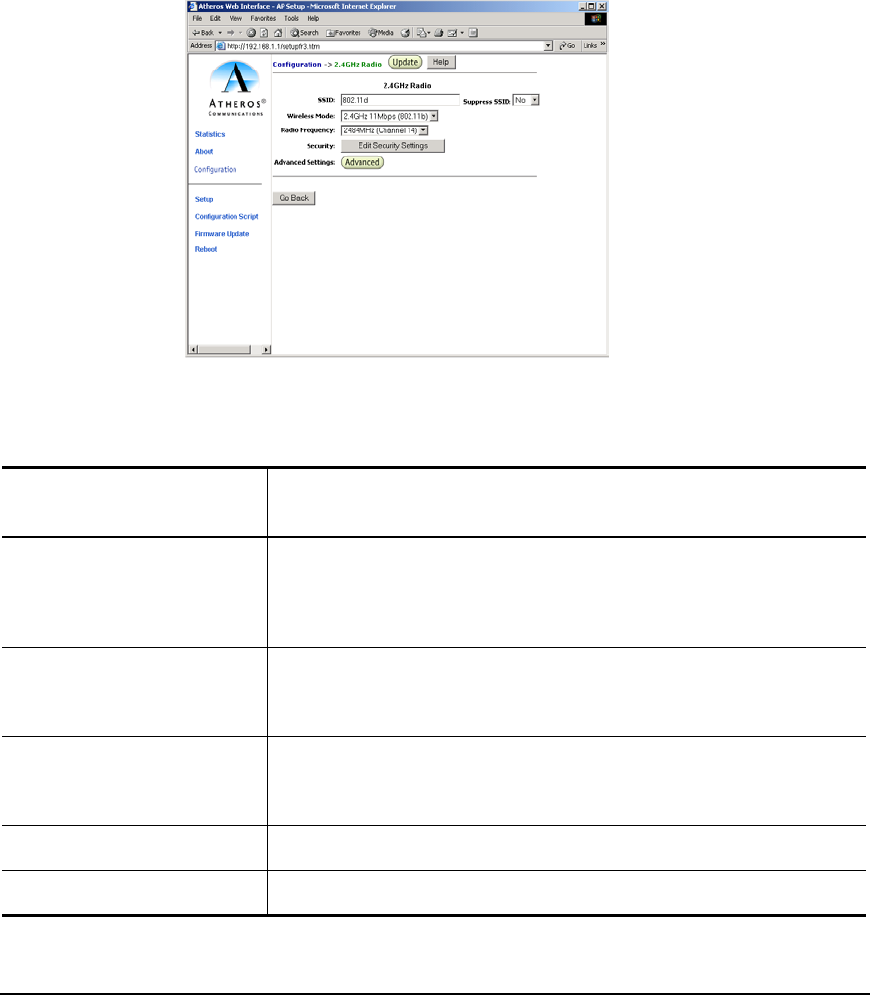
Atheros Communications, Inc. • 13
COMPANY CONFIDENTIAL November 2011• 14
2.4 GHz Radio Configuration Window
The 2.4 GHz Radio Configuration window allows the setting of generic 2.4 GHz radio
operating information for the AP. The Device’s firmware may limit the allowable settings
depending on Regulatory Domain (country) of operation. From the AP System
Configuration window, click on Edit 2.4 GHz Radio Settings to access the 2.4 GHz Radio
Configuration window.
This table summarizes the data fields on the 2.4 GHz Radio Configuration window.
General Configuration
Field Description
SSID Identification of the AP. Enter a number or address between 1 and 32
characters in length that the STAs are associating with in Infrastructure
mode. More than one AP in an SSID can be specified here. Use the
System Name field to uniquely identify each AP.
Suppress SSID Use the checkbox to prevent broadcast of the AP’s SSID in beacons. When
enabled, the SSID in beacons are not transmitted and only those STAs
with prior knowledge of an AP’s SSID can associate with that AP.
Wireless Mode The wireless LAN mode specifies both frequency range and data rates.
Firmware loaded on your version of the Access Point at the factory limits
the available channel settings.
Security: Edit Security Settings Click here to edit the security configuration for 2.4 GHz radio operation.
Advanced Settings Click here to enter advanced configuration for 2.4 GHz radio operation.

Atheros Communications, Inc. • 14
COMPANY CONFIDENTIAL November 2011 • 15
B
U.S. Regulatory
Wireless Notice
.

U.S. Regulatory Wireless Notice
Federal Communication Commission Interference Statement
This equipment has been tested and found to comply with the limits for a Class B
digital device, pursuant to Part 15 of the FCC Rules. These limits are designed to
provide reasonable protection against harmful interference in a residential installation.
This equipment generates, uses and can radiate radio frequency energy and, if not
installed and used in accordance with the instructions, may cause harmful
interference to radio communications. However, there is no guarantee that
interference will not occur in a particular installation. If this equipment does cause
harmful interference to radio or television reception, which can be determined by
turning the equipment off and on, the user is encouraged to try to correct the
interference by one of the following measures:
- Reorient or relocate the receiving antenna.
- Increase the separation between the equipment and receiver.
- Connect the equipment into an outlet on a circuit different from that
to which the receiver is connected.
- Consult the dealer or an experienced radio/TV technician for help.
FCC Caution: Any changes or modifications not expressly approved by the party
responsible for compliance could void the user's authority to operate this equipment.
This device complies with Part 15 of the FCC Rules. Operation is subject to the
following two conditions: (1) This device may not cause harmful interference, and (2)
this device must accept any interference received, including interference that may
cause undesired operation.
IMPORTANT NOTE:
FCC Radiation Exposure Statement:
This equipment complies with FCC radiation exposure limits set forth for an
uncontrolled environment. This equipment should be installed and operated with
minimum distance 20cm between the radiator & your body.
This transmitter must not be co-located or operating in conjunction with any other
antenna or transmitter.

This device is intended only for OEM integrators under the following
conditions:
1) The antenna must be installed such that 20 cm is maintained between
the antenna and users, and
2) The transmitter module may not be co-located with any other
transmitter or antenna.
As long as 2 conditions above are met, further transmitter test will not be
required. However, the OEM integrator is still responsible for testing their
end-product for any additional compliance requirements required with this
module installed
IMPORTANT NOTE: In the event that these conditions can not be met
(for example certain laptop configurations or co-location with another
transmitter), then the FCC authorization is no longer considered valid and
the FCC ID can not be used on the final product. In these circumstances,
the OEM integrator will be responsible for re-evaluating the end product
(including the transmitter) and obtaining a separate FCC authorization.
End Product Labeling
This transmitter module is authorized only for use in device where the
antenna may be installed such that 20 cm may be maintained between the
antenna and users. The final end product must be labeled in a visible area
with the following: “Contains FCC ID: H8N-WLL6240”. The grantee's FCC
ID can be used only when all FCC compliance requirements are met.
Manual Information To the End User
The OEM integrator has to be aware not to provide information to the end
user regarding how to install or remove this RF module in the user’s
manual of the end product which integrates this module.
The end user manual shall include all required regulatory
information/warning as show in this manual.